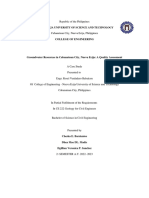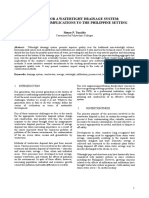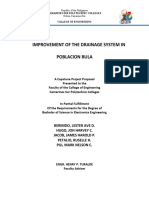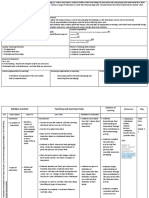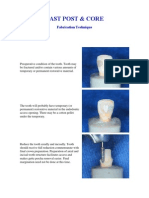PCS2 - Group - 4 - BSCE - 4A
PCS2 - Group - 4 - BSCE - 4A
Uploaded by
jianCopyright:
Available Formats
PCS2 - Group - 4 - BSCE - 4A
PCS2 - Group - 4 - BSCE - 4A
Uploaded by
jianOriginal Title
Copyright
Available Formats
Share this document
Did you find this document useful?
Is this content inappropriate?
Copyright:
Available Formats
PCS2 - Group - 4 - BSCE - 4A
PCS2 - Group - 4 - BSCE - 4A
Uploaded by
jianCopyright:
Available Formats
Republic of the Philippines 1
NUEVA ECIJA UNIVERSITY OF SCIENCE AND TECHNOLOGY
Cabanatuan city, Nueva Ecija, Philippines
ISO 9001:2015 CERTIFIED
COLLEGE OF ENGINEERING – Civil Engineering Department
Republic of the Philippines
Cabanatuan City, Nueva Ecija
Nueva Ecija University of Science and Technology
College of Engineering
UNIT IV -DESIGN FLOW COMPUTATION & PIPE CAPACITY FOR STORM SEWERS,
FLOOD PLAIN, SPILLWAY DESIGN, DESIGN STORMS AND DESIGN RUN-OFF, DESIGN
PRECIPITATION HYETOGRAPHS, FLOOD CONTROL RESERVOIR DESIGN & MODIFIED
RATIONAL METHOD
PCS 2 - FLOOD CONTROL AND DRAINAGE ENGINEERING
Members:
Bate, Ma. Cristine V.
Dela Cruz, Erica P.
Dichoso, Ericka S.
Maniquiz, Aira Mae S.
Engr. Alelie Joy Alejo
INSTRUCTOR
October 7, 2024
Transforming Communities through Science and Technology
Republic of the Philippines 2
NUEVA ECIJA UNIVERSITY OF SCIENCE AND TECHNOLOGY
Cabanatuan city, Nueva Ecija, Philippines
ISO 9001:2015 CERTIFIED
COLLEGE OF ENGINEERING – Civil Engineering Department
DESIGN FLOW COMPUTATIONS AND PIPE CAPACITY FOR STORM SEWERS
DESIGN FLOW COMPUTATIONS
Methods
1. Rational Method
– Used to find peak flows for storm sewers
If a rainfall of i intensity begins instantly and continues indefinitely, the rate of runoff
will increase until the time of concentration (tc).
Assumptions:
1. Peak runoff rate at the outlet is a function of the average rainfall rate during
(tc). (peak runoff does not result from a more intense storm of shorter duration
during which only a portion of the watershed is contributing to the runoff)
2. (tc). employed is the time for runoff to flow from the farthest point in the
watershed to the inflow point of the sewer being designed.
3. Rainfall intensity is constant throughout the storm duration.
RATIONAL FORMULA
The rational formula is given by: Q = CiA
Where:
Q = peak discharge in cfs which occurs at (tc).
i = rainfall intensity in in/hr (duration used to compute i = tc)
A = watershed area in acres
C = runoff coefficient (0 ≤C ≤ 1)
Transforming Communities through Science and Technology
Republic of the Philippines 3
NUEVA ECIJA UNIVERSITY OF SCIENCE AND TECHNOLOGY
Cabanatuan city, Nueva Ecija, Philippines
ISO 9001:2015 CERTIFIED
COLLEGE OF ENGINEERING – Civil Engineering Department
2. SCS-Runoff Method
– U.S Soil Conservation Service developed this method. By this method the
volume and peak of the runoff can be estimated for 24-hr design storm.
This method can be used for both urban and non- urban small watersheds.
The SCS method uses a dimensionless unit hydrograph and drainage inputs to
determine flow volumes and peak discharges.
SCS runoff equation is given as:
Ia = 0.2S
Q = Runoff depth (in)
P = Rainfall / precipitation (in)
S = Potential maximum retention after runoff begins (in)
Ia = Initial abstraction (in)
3. Modified Rational Method
- Modified rational method is an extension of the rational method for rainfalls
lasting longer than the time of concentration and the hydrograph.
The basic equation for the Modified Rational Method is: Qp=kCia
Transforming Communities through Science and Technology
Republic of the Philippines 4
NUEVA ECIJA UNIVERSITY OF SCIENCE AND TECHNOLOGY
Cabanatuan city, Nueva Ecija, Philippines
ISO 9001:2015 CERTIFIED
COLLEGE OF ENGINEERING – Civil Engineering Department
RUNOFF COEFFICIENT C
C is the most difficult variable to accurately determine in the rational
method. The fraction of rainfall that will produce peak flow depends on:
• Impervious cover - any type of human-made surface that doesn’t absorb
rainfall.
• Slope - a rising or falling surface.
• Surface detention - The portion of the storm rainfall that flows on the land
surface toward the channel but has not yet reached it.
• Interception - the capture of precipitation above the ground surface.
• Infiltration - the process by which water on the ground surface enters the
soil.
• Antecedent moisture conditions - the relative wetness or dryness of a sewer
shed, which changes continuously and can have a very significant effect
on the flow responses in these systems during wet weather.
Transforming Communities through Science and Technology
Republic of the Philippines 5
NUEVA ECIJA UNIVERSITY OF SCIENCE AND TECHNOLOGY
Cabanatuan city, Nueva Ecija, Philippines
ISO 9001:2015 CERTIFIED
COLLEGE OF ENGINEERING – Civil Engineering Department
C values based on land use C values based on soil groups
Rainfall Intensity (i)
• I : rainfall rate in in/hr
• i is selected based on rainfall duration and return period
– duration is equal to the time of concentration, tc
– return period varies depending on design standards
• tc = sum of inlet time (to) and flow time (tf) in the upstream sewers
connected to the outlet
Transforming Communities through Science and Technology
Republic of the Philippines 6
NUEVA ECIJA UNIVERSITY OF SCIENCE AND TECHNOLOGY
Cabanatuan city, Nueva Ecija, Philippines
ISO 9001:2015 CERTIFIED
COLLEGE OF ENGINEERING – Civil Engineering Department
tc = to + t f
Li is the length of the ith pipe along the flow path and
Where:
Vi is the flow velocity in the pipe.
PIPE CAPACITY FOR STORM SEWERS
-using manning equation
Manning Formula is used for:
• To find out the velocity of water in open channel
• To find the slope of pipe
• To find out the velocity of water in close channel
• To find out the pump of flow rate
Transforming Communities through Science and Technology
Republic of the Philippines 7
NUEVA ECIJA UNIVERSITY OF SCIENCE AND TECHNOLOGY
Cabanatuan city, Nueva Ecija, Philippines
ISO 9001:2015 CERTIFIED
COLLEGE OF ENGINEERING – Civil Engineering Department
OPEN CHANNEL PIPE FLOW
• OPEN CHANNEL – means a flow- through channel that is open to the
atmosphere and has free surface, the flow is produced because of gravity
that is obtained by providing a bed slope.
PIPE FLOW – pipe flow is a flow that takes place under pressure force. In
close flow or in close pipe close flow, the pipe has no free surface
OPEN CHANNEL FLOW
• Atmospheric pressure at free surface
• Gravity flow
• Roughness varies
• Any shape
• Velocity varies
PIPE FLOW
• No free surface
• Pressurize flow
• Roughness depends on material of pipe
• Circular
• Velocity is marls at center
Transforming Communities through Science and Technology
Republic of the Philippines 8
NUEVA ECIJA UNIVERSITY OF SCIENCE AND TECHNOLOGY
Cabanatuan city, Nueva Ecija, Philippines
ISO 9001:2015 CERTIFIED
COLLEGE OF ENGINEERING – Civil Engineering Department
STORM SEWER
• The capacity of storm
sewers depends on
various factors, including
the size and shape of the
pipe, slope, material, and
the design specifications.
Storm sewer systems are
designed to handle the flow of rainwater and prevent flooding in urban
areas. The capacity is typically expressed in terms of flow rate, often
measured in cubic foot per second (cfs) or cubic meter per second (cms).
PIPE CAPACITY FOR STORM SEWERS
Assumption: pipe is flowing full under gravity
MANNING’S EQUATION
3/8
2.16Qn
1.49 D=
Q= AR 2 / 3 S 1f / 2
S 0
n
Valid for Q in cfs and D in ft. For SI units (Q in m3/s and D in m), replace 2.16 with
3.21.
Transforming Communities through Science and Technology
Republic of the Philippines 9
NUEVA ECIJA UNIVERSITY OF SCIENCE AND TECHNOLOGY
Cabanatuan city, Nueva Ecija, Philippines
ISO 9001:2015 CERTIFIED
COLLEGE OF ENGINEERING – Civil Engineering Department
WHERE:
Q = flow rate
n = manning’s roughness coefficient
A = Cross sectional Area flow or flow area
R = hydraulic radius
S = slope of the channel
Example Problem 1:
Suppose you have a storm sewer with the following characteristics:
• Pipe diameter (D): 24 inches (0.6096 meters)
• Manning's roughness coefficient (n): 0.013 (typical for concrete pipes)
• Slope of the sewer (S): 0.005
• The sewer is flowing half full.
𝜋𝐷2 𝐴
𝐴= 𝑅=
4 𝑃
𝜋(0.6096)2 𝑃 = 1.9151𝑚 (𝑢𝑠𝑖𝑛𝑔 𝑡ℎ𝑒 𝑐𝑖𝑟𝑐𝑢𝑚𝑓𝑒𝑟𝑒𝑛𝑐𝑒 𝑓𝑜𝑟𝑚𝑢𝑙𝑎)
𝐴=
4
0.2918𝑚2
𝐴 = 0.2918𝑚 2 𝑅=
1.9151𝑚
1.49 2 1
𝑄= 𝐴𝑅3 𝑆𝑓 2
𝑛 𝑅 = 0.1524𝑚
1. 2 1
𝑄= 𝐴𝑅 3 𝑆𝑓 2
𝑛
1 2 1
𝑄= (0.2918𝑚2 )(0.1524𝑚)3 (0.005)2
0.013
𝑄 = 0.4528𝑚3 /𝑠
Transforming Communities through Science and Technology
Republic of the Philippines 10
NUEVA ECIJA UNIVERSITY OF SCIENCE AND TECHNOLOGY
Cabanatuan city, Nueva Ecija, Philippines
ISO 9001:2015 CERTIFIED
COLLEGE OF ENGINEERING – Civil Engineering Department
Example Problem 2:
Given Td =10 min, C = 0.6, ground elevations at the pipe ends (498.43 and 495.55
0.175
ft), length = 450 ft, Manning n = 0.015, i=120T / (Td + 27), compute flow, pipe
diameter and flow time in the pipe.
120(5) 0.175 Flow time = length of pipe / velocity
i= = 4.30 in / hr
(10 + 27)
450 450 1.752
= Apipe =
Q 10.3 4
Q = CiA = 0.6 4.30 4 = 10.3 cfs = 105 sec = 1.75 min
3/8
2.16Qn 2.16 10.3 0.015
3/8
D= = = 1.71 ft = 1.75 ft
S 0.0064
0
Transforming Communities through Science and Technology
Republic of the Philippines 11
NUEVA ECIJA UNIVERSITY OF SCIENCE AND TECHNOLOGY
Cabanatuan city, Nueva Ecija, Philippines
ISO 9001:2015 CERTIFIED
COLLEGE OF ENGINEERING – Civil Engineering Department
Floodplain
A floodplain (or floodplain) is a generally flat area of land next to a river or
stream. It stretches from the banks of the river to the outer edges of the valley. It
also represents the limits of the Base Flood Elevation or BFE (100-year or 1%
chance storms event) and there are limits as to what can be done within these
areas. Floodplains consist of two parts.
Floodway- The first is the main channel of the river itself. This designated height is
1 foot.
Floodway fringe or Flood fringe -Flood Fringe is the remaining portion of the
floodplain which extends from the outer banks of the floodway to the bluff lines
of a river valley. Bluff lines, also called valley walls, mark the area where the
valley floor begins to rise into bluffs.
Floodplain
Floodplains are formed in one of two ways.
Erosion- it is when the ground or soil is worn away by movement of water or
wind.
Aggradation - it happens when the middle of the river flows significantly faster
than the sides. It is also known as alluviation because the sediment and debris
that builds up is called alluvium.
If the building up of sediment happens within the riverbank, they are lateral
accretions.
Transforming Communities through Science and Technology
Republic of the Philippines 12
NUEVA ECIJA UNIVERSITY OF SCIENCE AND TECHNOLOGY
Cabanatuan city, Nueva Ecija, Philippines
ISO 9001:2015 CERTIFIED
COLLEGE OF ENGINEERING – Civil Engineering Department
If the building up of sediment happens on the floodplain during flooding, then
they are vertical accretions.
Spillway
A spillway is a structure used to provide the controlled release of water
downstream from a dam or levee, typically into the riverbed of the dammed
river itself. In the United Kingdom, they may be known as overflow
channels. Spillways can include floodgates and fuse plugs to regulate water
flow and reservoir level. Such features enable a spillway to regulate downstream
flow—by releasing water in a controlled manner before the reservoir is full,
operators can prevent an unacceptably large release later.
Components of Spillway
1. Body, Wier, or Spillway - it can be Ogee, U, semicircular, or circular in shape.
These are sometimes equipped with gates to regulate the flow of water.
2.Approach Channel - It removes excess water from the reservoir and directs it
to the downstream side. Furthermore, it aids in discharge control.
3.Energy Dissipators – these are available at the discharge channel’s
downstream end. Ski jump buckets and roller buckets are commonly used to
dissipated energy.
4. Trail Channel – it carries spillway discharge to the downstream side.
5. Guide wall- it guides the flow of water directly in to the reservoir downstream.
Transforming Communities through Science and Technology
Republic of the Philippines 13
NUEVA ECIJA UNIVERSITY OF SCIENCE AND TECHNOLOGY
Cabanatuan city, Nueva Ecija, Philippines
ISO 9001:2015 CERTIFIED
COLLEGE OF ENGINEERING – Civil Engineering Department
6.Discharge- the primary function of the discharge channel is to transport water
from the reservoir to the river safety.
Design Criteria for spillway
1. The spillway must be both hydraulically and structurally sound.
2. The spillway must have adequate capacity.
3. It must be situated in such a way that it allows for the safe disposal of
water
4. To withstand the high scouring velocity created by the drop from the
reservoir surface. The spillway surface must be erosion resistant.
5. On the downstream side of the spillway some kind of energy dissipation
device is usually required.
TYPES OF SPILLWAYS
STRAIGHT DROP SPILLWAY
-spillway consists of a low height weir wall having its downstream face
roughly or perfectly vertical.
-also known as free overfall spillway.
-it is the most suitable for thin arch dam’s earthen dams, or bunds.
OGEE SPILLWAY
-represents the shape of the downstream face of the weir.
- improved form of a straight drop spillway
Transforming Communities through Science and Technology
Republic of the Philippines 14
NUEVA ECIJA UNIVERSITY OF SCIENCE AND TECHNOLOGY
Cabanatuan city, Nueva Ecija, Philippines
ISO 9001:2015 CERTIFIED
COLLEGE OF ENGINEERING – Civil Engineering Department
- it is designed based on the principle of a projectile
-it can also be called as on overflow spillway
- it is most used in case of gravity dams, arch dams, buttress dams, etc
SHAFT SPILLWAY
- type of spillway which consist of vertical shaft followed by a horizontal
conduit.
- the shaft constructed is either artificial or natural.
- It also called as Morning glory spillway or Bell Mouth spillway
- Shaft spillway is recommended when there is no space to provide for
other types of spillways such as ogee spillway, straight drop spillway etc.
CHUTE SPILLWAY
-type of spillway in which surplus water from upstream is disposed to the
downstream through a steeply sloped open channel.
-is suitable for the gravity dams, earthen dam, rockfill dams, etc. But it is
preferred when the width of the river valley is very narrow.
-also called as trough spillway or open channel spillway.
Transforming Communities through Science and Technology
Republic of the Philippines 15
NUEVA ECIJA UNIVERSITY OF SCIENCE AND TECHNOLOGY
Cabanatuan city, Nueva Ecija, Philippines
ISO 9001:2015 CERTIFIED
COLLEGE OF ENGINEERING – Civil Engineering Department
LABYRINTH SPILLWAY
- is a type of dam spillway in which the weir wall is built in a zigzag manner to
increase the effective length of the weir crest in relation to the channel width.
This increase in effective length increases the weir's discharge capacity, allowing
for higher water flow at low heads that can be easily conveyed to the
downstream.
SIDE CHANNEL SPILLWAY
- is like chute spillway but the only difference is the crest of side channel spillway
is located on one of its sides whereas crest of chute spillway is located between
the side walls.
-preferred over chute spillway when flanks of sufficient width are not available.
SIPHON SPILLWAY
- A siphon spillway is a type of spillway in which surplus water is disposed to
downstream through an inverted U-shaped conduit.
- air vents are provided at the bent portion of the upper passageway to prevent
the entrance of water when the water level is below the normal poll level.
Types of Siphon Spillway
1. TITLED OUT TYPE OF SIPHON SPILLWAY
This type of dam spillway is provided when the valley is too narrow to
accommodate a separate spillway. In this case a siphon pipe can be
installed within the dam body. The siphon pipe is connected to an air
vent. The entry point is kept lower to prevent debris of floating matter from
Transforming Communities through Science and Technology
Republic of the Philippines 16
NUEVA ECIJA UNIVERSITY OF SCIENCE AND TECHNOLOGY
Cabanatuan city, Nueva Ecija, Philippines
ISO 9001:2015 CERTIFIED
COLLEGE OF ENGINEERING – Civil Engineering Department
entering the siphon. Suction in the air vent pipe begins as soon as the
water level rises. The siphonic action will continue until the water level to
normal.
2. HOODED TYPE OF SIPHON SPILLWAY
A R.C.C. Hood is built over an overflow section in this type of dam spillway.
The inlet is kept submerged to prevent debris from entering. Above the
main hood is a small deprimer hood connected by an air vent.
3. VOLUTE TYPE OF SIPHON SPILLWAY
This type of dam spillway consists of a vertical barrel that is bent at the
discharge end and opens out in the shape of a funnel at the top. The
funnel's lip is kept at the reservoir's permissible level. A few blades, similar
to those found in centrifugal pumps, are fixed in the funnel to introduce
spiral motion to the water passing through them. Over the funnel is a
concrete dam supported by several pillars. Deprimer hood is provided
over the main dome. When the water level rises, it seals the entry of air
and water starts flowing from all sides.
DESIGN STORM AND DESIGN RUNOFF
Design storm means a prescribed hyetograph and total precipitation amount
(for a specific duration recurrence frequency) used to estimate runoff for a
hypothetical storm for the purposes of analyzing existing drainage, designing
new drainage facilities or assessing other impacts of a proposed project on the
flow of surface water. (A hyetograph is a graph of percentages of total
precipitation for a series of time steps representing the total time during which
the precipitation occurs.
Transforming Communities through Science and Technology
Republic of the Philippines 17
NUEVA ECIJA UNIVERSITY OF SCIENCE AND TECHNOLOGY
Cabanatuan city, Nueva Ecija, Philippines
ISO 9001:2015 CERTIFIED
COLLEGE OF ENGINEERING – Civil Engineering Department
A design storm is a precipitation pattern or intensity value defined for design of
drainage facilities. Design storms are either based on historical precipitation
data or rainfall characteristics in the project area or region. Application of
design storms ranges from point precipitation for calculation of peak flows using
the rational method to storm hyetographs as input for rainfall-runoff analysis in
the hydrograph method.
Difference Of Design Storm and Design Runoff
A design storm is a hypothetical or statistically derived event used a standard
reference for designing water management and drainage system, representing
the expected or critical rainfall pattern for a specific location.
Design storms are crucial for sizing and designing storm water management
infrastructure, characterized by duration, intensity, and temporal distribution of
rainfall and are typically occurring once every 2, 10, 100 years.
Design runoff is the volume and rate of surface water runoff during a specific
storm event, crucial for hydrological analysis in designing drainage and storm
water management system.
Design runoff assessment determines peak flow rates and volume of runoff from
a storm, used to design drainage infrastructure, minimizing flooding and erosion
risk using hydrological method and factors like land use and soil types.
Transforming Communities through Science and Technology
Republic of the Philippines 18
NUEVA ECIJA UNIVERSITY OF SCIENCE AND TECHNOLOGY
Cabanatuan city, Nueva Ecija, Philippines
ISO 9001:2015 CERTIFIED
COLLEGE OF ENGINEERING – Civil Engineering Department
Design Precipitation Hyetographs
A design precipitation hyetograph is a graphical representation of the temporal
distribution of precipitation over a specific duration for a given location. It’s
commonly used in the hydrology and civil engineering to estimate the pattern
of rainfall during a storm event.
Hyetographs are graphs showing precipitation changes over time during a
storm. They are used to design storm water management system, such as
drainage systems and dams, based on historical rainfall data and statical
analysis. They provide a crucial information for sizing and capacity of these
systems.
EXAMPLE:
Transforming Communities through Science and Technology
Republic of the Philippines 19
NUEVA ECIJA UNIVERSITY OF SCIENCE AND TECHNOLOGY
Cabanatuan city, Nueva Ecija, Philippines
ISO 9001:2015 CERTIFIED
COLLEGE OF ENGINEERING – Civil Engineering Department
Transforming Communities through Science and Technology
Republic of the Philippines 20
NUEVA ECIJA UNIVERSITY OF SCIENCE AND TECHNOLOGY
Cabanatuan city, Nueva Ecija, Philippines
ISO 9001:2015 CERTIFIED
COLLEGE OF ENGINEERING – Civil Engineering Department
SUMMARY OF ANSWER:
Flood Control Reservoir Design
In accordance with engineering standards of care, reservoirs are to be
designed to provide stability and durability, as well as protect the quality of the
stored water. For any particular project there may be more than one
Transforming Communities through Science and Technology
Republic of the Philippines 21
NUEVA ECIJA UNIVERSITY OF SCIENCE AND TECHNOLOGY
Cabanatuan city, Nueva Ecija, Philippines
ISO 9001:2015 CERTIFIED
COLLEGE OF ENGINEERING – Civil Engineering Department
acceptable reservoir design concept. The reservoir design criteria are not
intended to establish any particular design approach, but rather to ensure
water system adequacy, reliability, and compatibility with existing and future
facilities.
Major requirements for modeling a flood system include:
1) Schematizing the basin by identifying operational control points, damage
index locations, and potential reservoirs,
2) Developing consistent basin-wide (control point by control point)
hydrology that could include one, or preferably more, historic events or
synthetic events,
3) Developing streamflow routing criteria for all stream reaches,
4) Characterizing reservoirs by their storage and release capacities,
5) Determining operation criteria such as selecting control points to operate
for, determining their safe flow capacity, and specifying release priorities,
6) Developing functional damage relations and base conditions
exceedance frequency relations for each damage index location.
In designing flood control reservoir systems should includes the physical
representation of the system (sites, storage, cost, stream conveyance, basin
technology) and the economic representation of the consequences of flooding
(damage centers, damage potential, frequency of flooding).
One of the examples of computer programed simulation of flood control and
conservation systems is HEC-5C has been developed by The Hydrologic
Engineering Center which may help the future programmers to innovate more
the flood control reservoir designs.
Transforming Communities through Science and Technology
Republic of the Philippines 22
NUEVA ECIJA UNIVERSITY OF SCIENCE AND TECHNOLOGY
Cabanatuan city, Nueva Ecija, Philippines
ISO 9001:2015 CERTIFIED
COLLEGE OF ENGINEERING – Civil Engineering Department
The Modified Rational Method
For drainage areas of less than 5 acres, a modification of the Rational Method
can be used for the estimation of storage volumes for detention calculations.
The Modified Rational Method uses the peak flow calculating capability of the
Rational Method paired with assumptions about the inflow and outflow
hydrographs to compute an approximation of storage volumes for simple
detention calculations. The rising and falling limbs of the inflow hydrograph have
a duration equal to the time of concentration (tc). An allowable target outflow is
set (Qa) based on pre-development conditions. The storm duration is td, and is
varied until the storage volume (shaded gray area) is maximized. It is normally an
iterative process done by hand or on a spreadsheet.
Figure 1.
Design Equations
Transforming Communities through Science and Technology
Republic of the Philippines 23
NUEVA ECIJA UNIVERSITY OF SCIENCE AND TECHNOLOGY
Cabanatuan city, Nueva Ecija, Philippines
ISO 9001:2015 CERTIFIED
COLLEGE OF ENGINEERING – Civil Engineering Department
The design of detention using the Modified Rational Method is presented as a
noniterative approach suitable for spreadsheet calculation (Debo & Reese,
1995).
The allowable release rate can be determined from:
Where:
Qa = allowable release rate (cfs)
Ca = predevelopment Rational Method run-off coefficient
i = rainfall intensity for the corresponding time of concentration (in/hr)
A = area (acres)
Table 1,
Example Problem.
Transforming Communities through Science and Technology
Republic of the Philippines 24
NUEVA ECIJA UNIVERSITY OF SCIENCE AND TECHNOLOGY
Cabanatuan city, Nueva Ecija, Philippines
ISO 9001:2015 CERTIFIED
COLLEGE OF ENGINEERING – Civil Engineering Department
Figure 2.
It is a series of “Trapezoidal” shaped hydrographs are created for different Storm
Durations. The “I” in the Rational equation is based upon the duration and not the
Time of Concentration, However the hydrographs initially peak at the original Time
of Concentration. The runoff volume from the pre-development hydrograph is
subtracted from each of the runoff volumes (areas under the Trapezoid), for each
storm duration. The greatest difference in volume between the pre and post
hydrographs becomes your critical hydrograph with respective critical storm
duration.
Construct a series of hydrographs for each selected duration of the storm as
shown in figure 2, Modified Rational Method Hydrographs. The estimated critical
storage for this site is 88,858 cubic feet. Since the inflow volume must equal the
outflow volume of 98,794 cubic feet, the time to the end of the release rate is 30.3.
To reach zero outflow approximately 0.5 hours must be added so the total
dewatering time will be about 30.3 hours. The outflow hydrograph reaches
Transforming Communities through Science and Technology
Republic of the Philippines 25
NUEVA ECIJA UNIVERSITY OF SCIENCE AND TECHNOLOGY
Cabanatuan city, Nueva Ecija, Philippines
ISO 9001:2015 CERTIFIED
COLLEGE OF ENGINEERING – Civil Engineering Department
maximum flow at the intersection with the falling limb of the hydrograph resulting
from a storm with a duration equal to the time of concentration.
Storage-Duration Values
Duration Intensity – Peak Flow – Volume of Release Required
of Storm i Q Runoff Flow Storage
(hr) (cuff) Volume Volume
(in/hr) (cfs)
(cuft) (cuft)
0.25 4.8 39.9 35,925 828 35,097
0.50 3.4 28.3 50,894 1,656 49,238
0.75 2.7 22.5 60,624 2,484 58,140
1.00 2.3 19.1 68,856 3,312 65,544
1.50 1.7 14.1 76,341 4,968 71,373
2.00 1.4 11.6 83,825 6,624 77,201
3.00 1.1 9.1 98,794 9,936 88,858
3.50 0.9 7.5 94,303 11,592 82,711
Runoff Coefficient (C) = 0.7
Area (A) = 11.88 acres
Transforming Communities through Science and Technology
Republic of the Philippines 26
NUEVA ECIJA UNIVERSITY OF SCIENCE AND TECHNOLOGY
Cabanatuan city, Nueva Ecija, Philippines
ISO 9001:2015 CERTIFIED
COLLEGE OF ENGINEERING – Civil Engineering Department
For Column 3
Peak Flow = Q = C i A
= 0.7 * 4.8 * 11.88
= 39.9 cfs
For Column 4
Runoff Volume = Q * Duration of Storm * 3600 sec
= 39.9cfs * 0.25hrs * 3600 sec
= 35,925 cu.ft
For Column 5
Release Volume = 0.92cfs * Duration of Storm * 3600sec
= 0.92 cfs * 0.25hrs * 3600sec
= 828 cu.ft
For Column 6
Required Storage = Runoff Volume – Release Volume
= 35,925 – 828
= 35,097 cu.ft
Transforming Communities through Science and Technology
Republic of the Philippines 27
NUEVA ECIJA UNIVERSITY OF SCIENCE AND TECHNOLOGY
Cabanatuan city, Nueva Ecija, Philippines
ISO 9001:2015 CERTIFIED
COLLEGE OF ENGINEERING – Civil Engineering Department
References:
https://www.enggjournals.com/ijet/docs/IJET13-05-04-031.pdf
https://web.njit.edu/~washd/cim305/download/notes/CHAPTERS/CH%202.p
df
Open Channel Flow – Manning Equation ReviewCivilPE. (n.d.). Retrieved
November 15, 2023, from https://www.reviewcivilpe.com/open-channel-flow-
manning-equation/
Manning’s Equation. (n.d.).
Www.fsl.orst.edu.https://www.fsl.orst.edu/geowater/FX3/help/8_Hydraulic_Re
ference/Manning_s_Equation.htm
Storm vs. Sanitary Sewer | STORM (STormwater Outreach for Regional
Municipalities). (n.d.). Www.azstorm.org.
https://www.azstorm.org/stormwater-101/storm-vs-sanitary-sewer
https://www.ce.utexas.edu/prof/maidment/GradHydro2010/Visual/DesignSt
orms.ppt
SlideShare from Scribd (2024)
https://www.slideshare.net/slideshow/hyetograph-and-hydrograph-
analysis/53358664
Wikimedia Commons. (August 28, 2015). Miho Dam Spillway [Online].
Available: https://upload.wikimedia.org/wikipedia/commons/9/9c/Miho_Da
m_spillway.jpg
Civil Engineering Dictionary. (August 28, 2015). Spillway Definition [Online].
Available: http://www.aboutcivil.org/spillway-definition-types-
classification.html
Transforming Communities through Science and Technology
Republic of the Philippines 28
NUEVA ECIJA UNIVERSITY OF SCIENCE AND TECHNOLOGY
Cabanatuan city, Nueva Ecija, Philippines
ISO 9001:2015 CERTIFIED
COLLEGE OF ENGINEERING – Civil Engineering Department
"Spillways components and types," March 19, 2018. [Online],
Available: https://image.slidesharecdn.com/spillwaysfinalppt-
180319085104/95/spillways-components-and-types-30-
638.jpg?cb=1521449546
National Geographic Society is a 501 (c)(3) organization. © 1996
- 2024 National Geographic Society:
https://education.nationalgeographic.org/resource/flood-plain/
US Army Corps of Engineers, March 1976.
https://www.hec.usace.army.mil/publications/TechnicalPapers/TP-44.pdf.
Paul Schiariti. Basic Hydrology.
https://www.hydrocad.net/pdf/The%20Modified%20Rational%20Method.pdf
August 2001. Water System Design Manual.
https://www.webpages.uidaho.edu/CE431/Handouts/WA%20DOH%20Water
%20Res%20Guidelines.pdf
Transforming Communities through Science and Technology
You might also like
- CaseDocument21 pagesCasejulx0416No ratings yet
- Saa6d170e-3 Engine PDFDocument90 pagesSaa6d170e-3 Engine PDFamin100% (4)
- Thesis Mo ToDocument38 pagesThesis Mo ToLester Ave BermidoNo ratings yet
- Full Paper - Watertight Drainage SystemDocument7 pagesFull Paper - Watertight Drainage SystemHenry TuraldeNo ratings yet
- RBEC PELC Science and HealthDocument51 pagesRBEC PELC Science and Healthglenn0104No ratings yet
- 356908-Prac Tool - Mood Diary WorksheetDocument2 pages356908-Prac Tool - Mood Diary WorksheetCvetanka BurzevskaNo ratings yet
- Gatsby False Prophet of The American Dream EssayDocument2 pagesGatsby False Prophet of The American Dream EssayKarichmarie Marrero RodriguezNo ratings yet
- PCS2 Group 5 4ADocument96 pagesPCS2 Group 5 4AjianNo ratings yet
- Hidrologi #2Document36 pagesHidrologi #2EVAFYNo ratings yet
- Storm Drainage SystemDocument6 pagesStorm Drainage SystemMarifer De Guzman PolintanNo ratings yet
- Sewerage ConsiderationsDocument54 pagesSewerage ConsiderationscastrorezzaNo ratings yet
- Capstone FinalDocument12 pagesCapstone Finalmathynil41No ratings yet
- Enviranmental Engineering NotesDocument103 pagesEnviranmental Engineering Notes17-3A5 SHASHI NELLIVALASANo ratings yet
- Lab Manual 3.3 - LEVEL 1 - Measurement of Flow Over Broad Crestedsharp Crested Weir.Document4 pagesLab Manual 3.3 - LEVEL 1 - Measurement of Flow Over Broad Crestedsharp Crested Weir.Muhamad IzzanNo ratings yet
- School of Civil Engineering: HE Niversity of UeenslandDocument52 pagesSchool of Civil Engineering: HE Niversity of UeenslandUmair AfzalNo ratings yet
- Hydraulics and Water Resources Engineering 1Document27 pagesHydraulics and Water Resources Engineering 1Danika Kaye GornesNo ratings yet
- Improvement of The Drainage System in Poblacion BulaDocument37 pagesImprovement of The Drainage System in Poblacion BulaLester Ave BermidoNo ratings yet
- PBL 3Document2 pagesPBL 3chegg237No ratings yet
- Fluid Mechanics I I Lab ManualDocument30 pagesFluid Mechanics I I Lab ManualVivek Thakur SujanianNo ratings yet
- The Problem and Its Scope Rationale of The StudyDocument107 pagesThe Problem and Its Scope Rationale of The StudyFrederick Perez IINo ratings yet
- Epanet ReportDocument54 pagesEpanet ReportTan Chin Kong100% (1)
- 2 Chapter 1Document10 pages2 Chapter 1Francis TampocoNo ratings yet
- Case Study On Water Supply and DistributionDocument27 pagesCase Study On Water Supply and Distributionjohn felix cuadroNo ratings yet
- MASMA: Flood Flow EstimationDocument42 pagesMASMA: Flood Flow EstimationNur Syazana100% (2)
- Tube Settling ThailandDocument110 pagesTube Settling ThailandbkkbrazilNo ratings yet
- Department of Civil Engineering: Reticulation DesignDocument30 pagesDepartment of Civil Engineering: Reticulation Designanon_307271108100% (1)
- CE309 Water Resources Engineering PDFDocument3 pagesCE309 Water Resources Engineering PDFAshker DxNo ratings yet
- Permeability AssignmentDocument2 pagesPermeability AssignmentJejomar MotolNo ratings yet
- 6.+v9i3+minal Paper+monikaDocument6 pages6.+v9i3+minal Paper+monikaUpendra SaharkarNo ratings yet
- Nalytical Modelling of Groundwater Wells and Well Systems How To Get It RightDocument40 pagesNalytical Modelling of Groundwater Wells and Well Systems How To Get It RightMagdy BakryNo ratings yet
- Introductory Hydrology PracticalDocument26 pagesIntroductory Hydrology PracticalBamise AlabiNo ratings yet
- Laboratory Activity 2 Discharge Measurment Using Measuring TankDocument11 pagesLaboratory Activity 2 Discharge Measurment Using Measuring TankChardel Porlares100% (2)
- Environmental Engineering 2Document10 pagesEnvironmental Engineering 2rajitha shajiNo ratings yet
- Numerical Simulation of The Dynamic Operation of Multi-Outlet Siphonic Roof Drainage SystemsDocument12 pagesNumerical Simulation of The Dynamic Operation of Multi-Outlet Siphonic Roof Drainage SystemsDuzzysNo ratings yet
- ch2 - 1-UnlockedDocument19 pagesch2 - 1-UnlockedalshutuNo ratings yet
- Storm Drainage DesignDocument10 pagesStorm Drainage DesignIco PangilinanNo ratings yet
- Study of Seepage Losses From Irrigation Canals Using Radioactive Tracer TechniqueDocument58 pagesStudy of Seepage Losses From Irrigation Canals Using Radioactive Tracer Techniquechaudharylucky1818.sNo ratings yet
- Nota WastewaterDocument120 pagesNota WastewaterMohd Izdiharudin Ibrahim100% (1)
- Running wasterDocument8 pagesRunning wasterMycah Loraine Allauigan CalaunanNo ratings yet
- Continuation of Water DistributionDocument7 pagesContinuation of Water DistributionLyza AlvarezNo ratings yet
- Minor Project - 15CE375L - Templte For Review - 1.Document27 pagesMinor Project - 15CE375L - Templte For Review - 1.gfgfghNo ratings yet
- Chapter IDocument8 pagesChapter Isteve jaymeNo ratings yet
- Gutter DesignDocument15 pagesGutter Designkiritu.juliet18No ratings yet
- Distribution SystemDocument18 pagesDistribution SystemChirag SolankiNo ratings yet
- Drainase PasteurDocument10 pagesDrainase PasteurAndhika SasongkoNo ratings yet
- Muskingam Routing PDFDocument35 pagesMuskingam Routing PDFDario PrataNo ratings yet
- S7 - P7 - Apetroi Ioan VladutDocument17 pagesS7 - P7 - Apetroi Ioan VladutGabriel IloschiNo ratings yet
- BTech Project FinalDocument39 pagesBTech Project Final2101603No ratings yet
- Specification For Structural Joints Using ASTM325 or A490Document57 pagesSpecification For Structural Joints Using ASTM325 or A490PackiarajNo ratings yet
- PHD Thesis On Groundwater QualityDocument5 pagesPHD Thesis On Groundwater QualityHelpMeWriteMyEssayManchester100% (3)
- Kaur 2017 IOP Conf. Ser. Mater. Sci. Eng. 251 012128Document9 pagesKaur 2017 IOP Conf. Ser. Mater. Sci. Eng. 251 012128gesap35224No ratings yet
- Uso de EpanetDocument10 pagesUso de EpanetMarkito Dominguez RNo ratings yet
- PLMB-BLDG OwnerDocument21 pagesPLMB-BLDG OwnermazjamiNo ratings yet
- Engineering Hydrology (Book)Document328 pagesEngineering Hydrology (Book)thakurkanhaiyya100% (1)
- Syllabus For Water Supply EngineeringDocument2 pagesSyllabus For Water Supply EngineeringMd zakirNo ratings yet
- Day 1 - 06 Operational Management Marina Bay Singapore (Lee and Eikaas)Document38 pagesDay 1 - 06 Operational Management Marina Bay Singapore (Lee and Eikaas)hutuguoNo ratings yet
- Ce142p-5 A71 Experiment5Document4 pagesCe142p-5 A71 Experiment5Mark Allen FlorNo ratings yet
- Pipe Distribution Network For Irrigation System: ISSN (PRINT) : 2393-8374, (ONLINE) : 2394-0697, VOLUME-7, ISSUE-6, 2020Document12 pagesPipe Distribution Network For Irrigation System: ISSN (PRINT) : 2393-8374, (ONLINE) : 2394-0697, VOLUME-7, ISSUE-6, 2020njha19690719No ratings yet
- CANAL LINING SEMINAR REPORT PrakashDocument10 pagesCANAL LINING SEMINAR REPORT PrakashChirag SolankiNo ratings yet
- 4410 Chapt7 Water Conveying ConduitsDocument13 pages4410 Chapt7 Water Conveying ConduitsRJ ZambareNo ratings yet
- Water Resources 08 Sewerage SystemsDocument16 pagesWater Resources 08 Sewerage SystemsEdbert de los SantosNo ratings yet
- Water SupplyDocument37 pagesWater SupplyGTS100% (1)
- Hazardous-Waste-GROUP-6-PPTDocument52 pagesHazardous-Waste-GROUP-6-PPTjianNo ratings yet
- MATERIAL-COST (1)Document31 pagesMATERIAL-COST (1)jianNo ratings yet
- WRDocument9 pagesWRjianNo ratings yet
- Three-Reservoir (1)Document6 pagesThree-Reservoir (1)jianNo ratings yet
- Pcs 1111 Research Title (1)Document2 pagesPcs 1111 Research Title (1)jianNo ratings yet
- WBS-GeraldsmDocument1 pageWBS-GeraldsmjianNo ratings yet
- Parent FormDocument1 pageParent FormjianNo ratings yet
- 31869156-Construction-Cost-Estimate-WorksheetDocument12 pages31869156-Construction-Cost-Estimate-WorksheetjianNo ratings yet
- Total-Hydrostatic-Force-on-Curved-Surfaces (1)Document11 pagesTotal-Hydrostatic-Force-on-Curved-Surfaces (1)jianNo ratings yet
- MATERIAL-COSTDocument14 pagesMATERIAL-COSTjianNo ratings yet
- CASHFLOWDocument1 pageCASHFLOWjianNo ratings yet
- Open-Channels-part-2 (1)Document18 pagesOpen-Channels-part-2 (1)jianNo ratings yet
- Report Highway EngineeringDocument33 pagesReport Highway EngineeringjianNo ratings yet
- GROUP 2 RAINWATER HARVESTING SYSTEM Roof Lawns Parking Spaces 1Document21 pagesGROUP 2 RAINWATER HARVESTING SYSTEM Roof Lawns Parking Spaces 1jianNo ratings yet
- Katana Productionschedule TemplateDocument3 pagesKatana Productionschedule TemplatejianNo ratings yet
- Lab 1 4Document5 pagesLab 1 4jianNo ratings yet
- NumsolDocument13 pagesNumsoljianNo ratings yet
- School SuppliesDocument5 pagesSchool SuppliesjianNo ratings yet
- Es Reviewer PDFDocument7 pagesEs Reviewer PDFjianNo ratings yet
- Computer Science Project FileDocument23 pagesComputer Science Project Filekaushalmaurya738No ratings yet
- Toilet and Bath Accessories - MSTDocument7 pagesToilet and Bath Accessories - MSTwafikmh4No ratings yet
- Globalization PowerpointDocument41 pagesGlobalization PowerpointArjay Jimenez0% (1)
- Dissertation Scope of ResearchDocument8 pagesDissertation Scope of ResearchCustomPapersOnlineCanada100% (1)
- 2020-2023 Pay Increases Local 308Document1 page2020-2023 Pay Increases Local 308Chicago Transit Justice CoalitionNo ratings yet
- D T Assignment 2Document12 pagesD T Assignment 2api-333375058No ratings yet
- TELEFUNKEN Semiconductors: 查询ANT018供应商 捷多邦,专业PCB打样工厂,24小时加急出货Document9 pagesTELEFUNKEN Semiconductors: 查询ANT018供应商 捷多邦,专业PCB打样工厂,24小时加急出货draNo ratings yet
- Techbox Systems DSL PDFDocument4 pagesTechbox Systems DSL PDFMichael MedinaNo ratings yet
- Revisi Pengadaan Obat 2023 New 2Document62 pagesRevisi Pengadaan Obat 2023 New 2bahrulmaghfiroh CINo ratings yet
- STAT170 Research 3Document4 pagesSTAT170 Research 3Biyan HariyantoNo ratings yet
- Systems Analysis and Design: Analyzing The Business CaseDocument40 pagesSystems Analysis and Design: Analyzing The Business CaseMaxbuub AxmedNo ratings yet
- Post and Core FabricationDocument8 pagesPost and Core FabricationSaj1985No ratings yet
- Trac Nghiem 9331Document9 pagesTrac Nghiem 9331Hoan TranNo ratings yet
- Maths HotsDocument43 pagesMaths HotsAshish SethiNo ratings yet
- Vintage Minimalist Animated Artist Portfolio Presentation - 20231115 - 193720 - 0000Document39 pagesVintage Minimalist Animated Artist Portfolio Presentation - 20231115 - 193720 - 0000Sneha PhukanNo ratings yet
- Input Output Devices AssignmentDocument6 pagesInput Output Devices Assignmentpubg broNo ratings yet
- PROJECT Proposal ON INFLATIONDocument46 pagesPROJECT Proposal ON INFLATIONNjoguNo ratings yet
- Report Adjustable Power Supply 2Document11 pagesReport Adjustable Power Supply 2Deeo DhadiwalNo ratings yet
- Bench Marketing Strategy Plan: Group 6-11-Blue OceanDocument28 pagesBench Marketing Strategy Plan: Group 6-11-Blue Oceankristinesantos016No ratings yet
- Master Locksmiths Association 2016 HandbookDocument82 pagesMaster Locksmiths Association 2016 Handbookchieflittlehorse100% (3)
- Spare Parts List: CR 10-X CR Reader CR 12-X CR Advanced Reader CR 15-X CR Multiformat ReaderDocument16 pagesSpare Parts List: CR 10-X CR Reader CR 12-X CR Advanced Reader CR 15-X CR Multiformat Readermecool acemax100% (1)
- The Use of Bubble CPAP in Premature InfantsDocument7 pagesThe Use of Bubble CPAP in Premature InfantsRyan Rahman OesmanNo ratings yet
- ZAwaDocument12 pagesZAwaarness22No ratings yet
- RuinerDocument2 pagesRuinerSarahNo ratings yet
- Counter Rust 7010 TDSDocument2 pagesCounter Rust 7010 TDSFadhli KusumaNo ratings yet
- Community Assignment - 1Document6 pagesCommunity Assignment - 1Ashu BlueNo ratings yet
